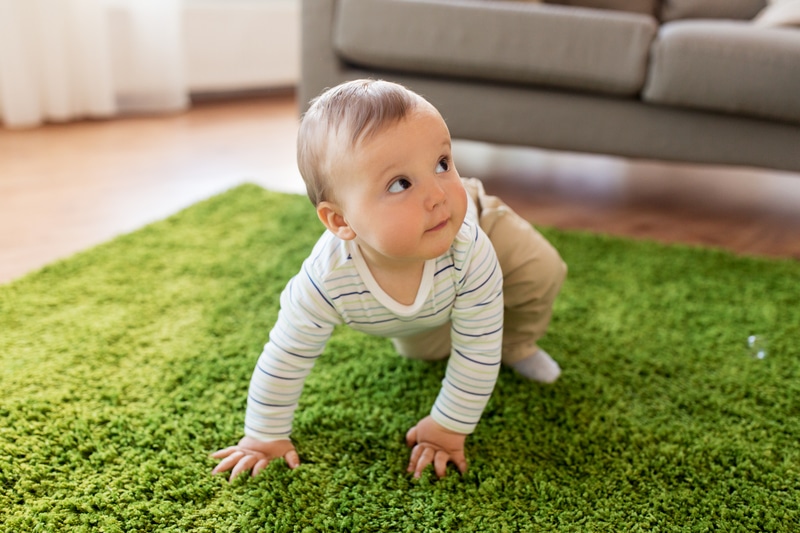
From a geometric, statement piece area rug to beige wall-to-wall in the hallway, rugs and carpets lend a pleasant coziness to our homes. Unfortunately, they’re also one of the largest contributors to toxin exposure in your home. In fact, California Department of Toxic Substances Control has identified carpets and rugs as the largest potential sources of significant and widespread PFAS exposures, especially for children. Mic drop. So, now that you’re sufficiently freaked out, here’s what you need to know about identifying and replacing your floor coverings and cleaners with non-toxic carpeting.
3 Questions to ask in your search for non-toxic carpeting
1. What chemicals am I trying to avoid?
Like clothing, bedding and mattresses, carpets are some of the most trafficked areas of our home. Our children and pets spend a lot of time playing and interacting with the surface. The quest for non-toxic carpeting is tough as carpets and their backings are often made of synthetic materials, treated with hazardous chemical sprays and then installed with adhesives. Older carpets in particular can contain toxins like endocrine-disruptors, phthalates, and Volatile Organic Compounds (VOCs), which can contribute to a variety of health issues like organ and nervous system damage and cancer. Much of conventional new carpeting is made from problematic material, especially the backings, such as the Styrene Butadien rubber backing found on 95% of carpets, which off gas both styrene, a carcinogen and 4-PC, a form of polycarbonate, which have been linked to cancer. The most important thing to seek out, however, is the many treatments carpet manufacturers use. Make sure to avoid are flame retardants, waterproofing and stain treatments, as they usually contain PFCs, which are perfluorinated compounds, the same liquid-repelling technology as nonstick cookware. PFCs are highly toxic, never break down in the environment, and build up in your body where they have been linked to a host of scary health issues.
This same logic applies to how rugs are installed as rug pads are often made from some pretty nasty materials and rug adhesives, used for wall-to-wall carpeting, can contain dangerous VOCs.
2. How do I choose non-toxic carpeting for my home?
Whenever possible, go with a more non-toxic and eco-friendly flooring choice like wood or tile that’s installed with low VOC materials. If some carpeting is needed, go for area rugs over wall-to-wall carpeting to reduce your exposure to adhesive and other installation materials that are hazardous.
Then, get choosy about your materials. Our top choice? Wool! It’s sustainable, durable and soft. Other natural materials that make excellent non-toxic carpets that also offer some interior design bang-for-your-buck are jute, seagrass and sisal. Just make sure to choose one that has not been treated with any additional chemicals, like a stain-resistant or water-resistant barrier. Rug pads also come in natural fibers like wool and natural rubber.
Finally, if you can’t avoid using a synthetic carpet, check out brands that are vetted by groups like Greenguard, a body that screens products for indoor air pollutant VOCs. But (there’s always a but!) remember that, while a product can be certified as safe from a VOC standpoint, it may still contain other hazards that the certifying organization may not screen for, like phthalates.
As you decide on floorings in your home, consider this: wall-to-wall in a rarely-used guest bathroom isn’t as important as the living room rug your sweet baby is learning to crawl on. Try to prioritize the safest materials for the high-traffic areas in your home. For more information, the Environmental Working Group’s Healthy Home resource has a great guide on carpets.
3. How Do I Clean It?
Okay, so now that you have had to settle for a carpet that’s not going to magically repel everything your kids and pets drag all over it (sorry!), how are you going to keep it clean?
First, check out carpet cleaning products on resources like the Environmental Working Group’s database to rule out any toxic bad guys by weeding out some of the worst ingredients and picking a safer carpet cleaner. Carpet cleaning solutions can include PFCs! So make sure you’re scanning the labels for anything containing the term “fluoro” to help you avoid them. Other major ingredients to weed out: fragrance (an proprietary term that allows manufacturers to hide ingredients that may be toxins and allergens) and ammonium hydroxide, a respiratory irritant, allergen and aquatic pollutant.
For the big, bad messes, there are non-toxic options that are still powerful enough to take care of the problem without exposing your family to harmful toxins. Here at Force of Nature, we’re always here to help you clean every surface in your home, from carpets to countertops, without exposing you to harmful toxins. Learn more about our revolutionary cleaning system that’s as effective as Resolve, but safe enough for a tummy time mat.



